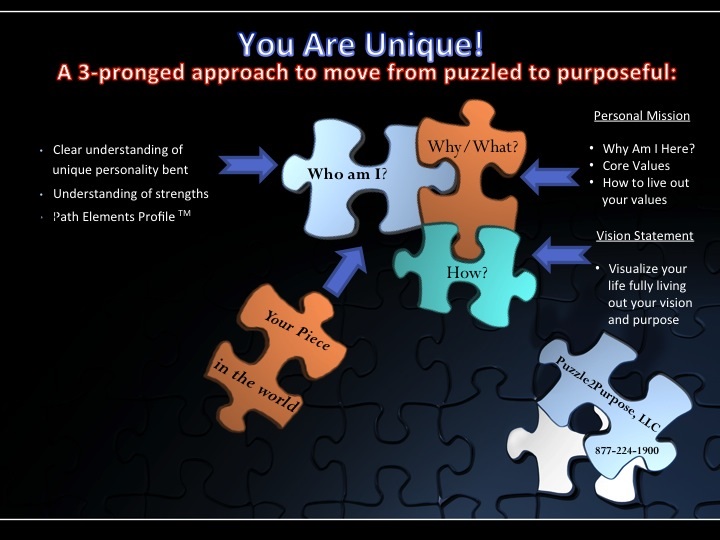A Coaching Model Created by Carol Keith
(Life Coaching, UNITED STATES)
You Are Unique!
Clients often come to coaching because they are puzzled about something in their lives – a job, a career change, a relationship, a choice they have to make, or even the age-old question,
What am I here for?
The philosophy behind Puzzle2Purpose begins with the idea that clients have puzzles in their lives. It becomes a goal for many to sort out those pieces into a cohesive whole. It is my thesis however, that to stop at the point of solving personal puzzles is short-sighted and ultimately is doing the client a disservice, hence the name Puzzle2Purpose. There are 2 aims in my coaching practice. One is to assist the client with solving their personal puzzles and the other is to assist the client with the discovery of how and where their “puzzle piece”, their life, fits into the larger puzzle of life – be it family, community, nation or the world at large.
I use a 3-pronged approach with my coaching clients to move them from being puzzled to being purposeful.
Step One: WHO? = Path Elements ProfileTM
Step Two: WHY/WHAT? = Personal Mission Statement
Step Three: HOW? = Vision Statement
Who:
I lay the foundation of our coaching together with the concept that the client is unique by employing the use of the Path Elements ProfileTM (PEP), so that the client has a clear understanding of their unique personality bent and preferred style of communication. Defining oneself as a unique piece of the puzzle is the first step in laying a firm foundation on which to build.
The client comes to an understanding of their strengths, their natural bent and a variety of ways to use them most effectively.
Additionally, the coaching includes a detailed understanding of how to pull from their lesser elemental tendencies as circumstances warrant.
Finally, clients use this self-awareness to define and see themselves clearly as unique individuals.
I describe using PEP as
building the house upon rock rather than shifting sands.
Why/What:
The second prong of my approach is to assist the client with developing their own personal mission statement – the
why am I here?
Imagine if you will that you have entered a room that contains a large round table, covered with a white tablecloth that hangs to the floor.
On that table is a large puzzle with 2500 tiny pieces. The background of the puzzle is a sea of faces – all shapes, sizes and colors. One puzzle piece is missing.
The white tablecloth shows through in stark contrast to the rest of the puzzle. Your eye is drawn to the missing puzzle piece.
YOU are a uniquely shaped piece in the puzzle of life. You are uniquely shaped, sized, colored and gifted for your unique purpose. You are a piece of the puzzle of your family, a piece of the puzzle of your community, a piece of the puzzle of your nation and a piece of the puzzle of the world. I cannot fulfill your purpose and you cannot fulfill mine. Just like the puzzle, if you are not clear about, and do not fulfill your purpose, your puzzle piece is missing.
Together as client and coach, we seek to discover the core values that speak to the client’s heart. Then we carefully choose three (3) verbs that describe how the client wishes to breathe life into that core value.
For example: I am on a mission to discover, inspire and encourage uniqueness.
Uniqueness is the core value and the three (3) action verbs are discover, inspire and encourage.
A mission statement will cover all aspects of life, from work to relationships and everything in between.
How:
The third prong of my coaching approach encourages the client to imagine their life as living fully in their mission and purpose. This phase constitutes the work of developing a vision statement.
A vision statement is written in the present tense as though you are already living it. It is a work of deep visualization. A vision statement will be saturated with descriptive details, sights, smells, sounds and emotions that best capture the dreams, or vision, of the client. The vision statement often keeps the client energized when motivation to attain goals might wane.
Our vision work will not become an integral part of a client’s journey without finding a place in the community, local or at large, where they may live out their mission, vision and purpose to “pay it forward” for others. The possibilities for creativity in this area are limitless.
Conclusion:
To coach and client alike, I would say:
If we are content to stop our coaching and our learning at setting our individual puzzle pieces in place in our lives, then we have missed the personal fulfillment of placing our puzzle piece into the larger puzzle.
More importantly, we have either by commission or omission left our puzzle piece out of the larger puzzle.
We have, in a sense, left a hole in the puzzle of life – a hole that can only be filled with our puzzle piece.
YOU ARE UNIQUE. If you do not embrace and fulfill your unique purpose we are all the lesser for it.

